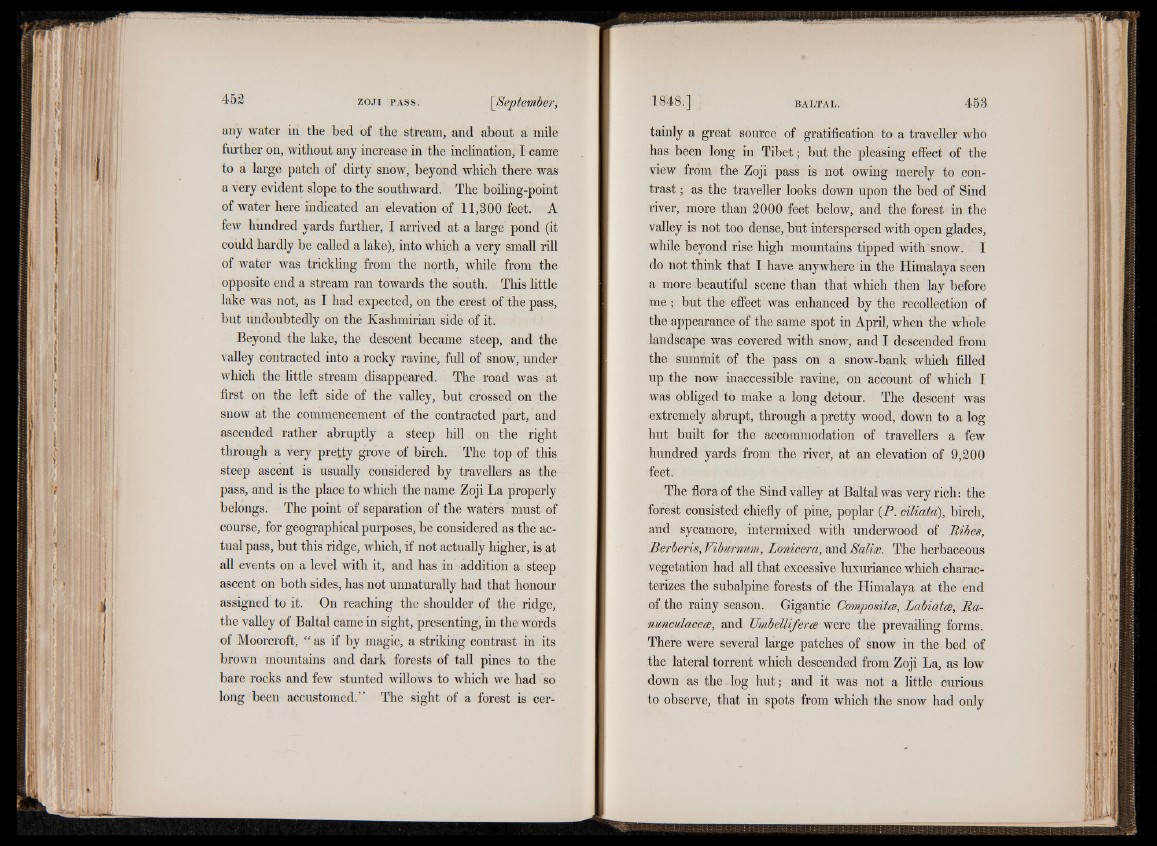
any water in the bed of the stream, and about a mile
further on, without any increase in the inclination, I came
to a large patch of dirty snow, beyond which there was
a very evident slope to the southward. The boiling-point
of water here indicated an elevation of 11,300 feet. A
few hundred yards further, I arrived at a large pond (it
could hardly be called a lake), into which a very small rill
of water was trickling from the north, while from the
opposite end a stream ran towards the south. This little
lake was not, as I had expected, on the crest of the pass,
but undoubtedly on the Kashmirian side of it.
Beyond the lake, the descent became steep, and the
valley contracted into a rocky ravine, full of snow, under
which the little stream disappeared. The road was at
first on the left side of the valley, but crossed on the
snow at the commencement of the contracted part, and
ascended rather abruptly a steep hill on the right
through a very pretty grove of birch. The top of this
steep ascent is usually considered by travellers as the
pass, and is the place to which the name Zoji La properly
belongs. The point of separation of the waters must of
course, for geographical purposes, be considered as the actual
pass, but this ridge, which, if not actually higher, is at
all events on a level with it, and has in addition a steep
ascent on both sides, has not unnaturally had that honour
assigned to it. On reaching the shoulder of the ridge,
the valley of Baltal came in sight, presenting, in the words
of Moorcroft, “ as if by magic, a striking contrast in its
brown mountains and dark forests of tall pines to the
bare rocks and few stunted willows to which we had so
long been accustomed.” The sight of a forest is certainly
a great source of gratification to a traveller who
has been long in Tibet ; but the pleasing effect of the
view from the Zoji pass is not owing merely to contrast
; as the traveller looks down upon the bed of Sind
river, more than 2000 feet below, and the forest in the
valley is not too dense, but interspersed with open glades,
while beyond rise high mountains tipped with snow. I
do not think that I have anywhere in the Himalaya seen
a more beautiful scene than that which then lay before
me ; but the effect was enhanced by the recollection of
the appearance of the same spot in April, when the whole
landscape was covered with snow, and I descended from
the summit of the pass on a snow-bank which filled
up the now inaccessible ravine, on account of which I
was obliged to make a long detour. The descent was
extremely abrupt, through a pretty wood, down to a log
hut built for the accommodation of travellers a few
hundred yards from the river, at an elevation of 9,200
feet.
The flora of the Sind valley at Baltal was very rich: the
forest consisted chiefly of pine, poplar (P. ciliata), birch,
and sycamore, intermixed with underwood of Ribes,
Berberis, Viburnum., Lonicera, and Salix. The herbaceous
vegetation had all that excessive luxuriance which characterizes
the subalpine forests of the Himalaya at the end
of the rainy season. Gigantic Compositoe, Labiatæ, Ra-
nunculaceæ, and TJmbelliferoe were thé prevailing forms.
There were several large patches of snow in the bed of
the lateral torrent which descended from Zoji La, as low
down as the.log hut; and it was not a little curious
to observe, that in spots from which the snow had only